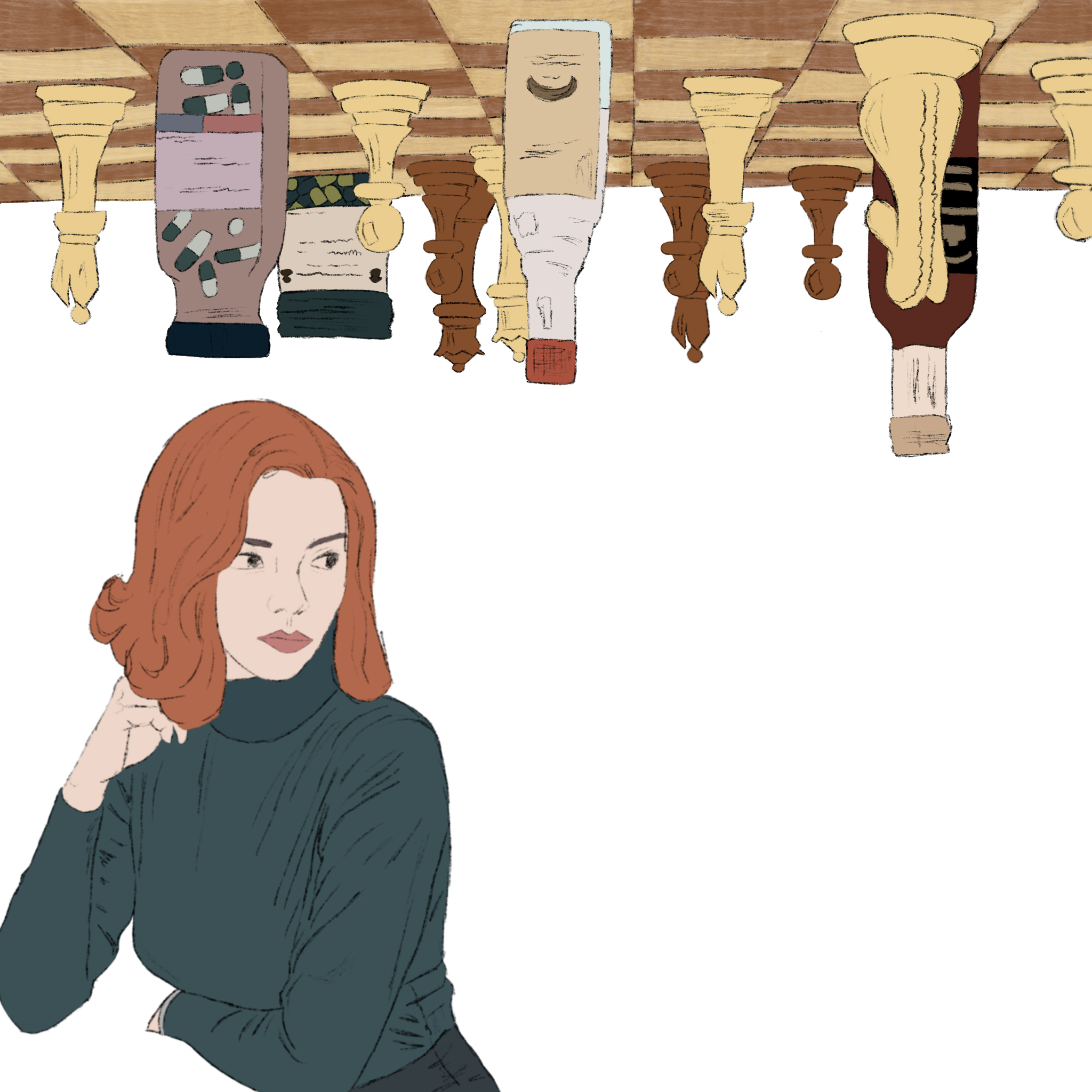By Sandra Saade, Rita Kimijima-Dennemeyer, and Laura-Bianca Pasca
Image Credit: Daffodil Dhayaa
Humanity will not wait millions of years until Mother Nature will hand it a functionally better brain…[Humankind] will directly, openly and consciously take part in evolution.
Corneliu E. Giurgea
In Netflix’ groundbreakingly popular mini-series The Queen’s Gambit, we witness the prodigious performance of fictional chess player Beth Harmon, which is dependent on an abusive use of sedatives. Capable of thoughts beyond other people’s comprehension, but hiding behind a dark secret—it’s such a common trope! From Sherlock’s addiction to cocaine to Criminal Minds’ Spencer Reid’s abuse of painkillers, we have seen the fuelling of genius through addiction before.
The pills, (called “Xanzolam”), are also fictional, but they are most likely based on benzodiazepine medication– more specifically, on chlordiazepoxide, which has been marketed as Librium from its approval in the 1960s, when the show is set.
Benzodiazepines
Benzodiazepines are usually prescribed to treat anxiety or insomnia, as they have a calming effect due to their enhancement of a neurotransmitter known as gamma aminobutyric acid (GABA). This acts as a chemical messenger that inhibits certain signals of the brain, and decreases activity in the nervous system by binding to a protein known as a GABA receptor. Benzodiazepines work by binding on certain sites of these receptors, inducing a change that leads to an increase in the receptors’ efficacy at binding GABA.
In the series, Beth is given the pills at the orphanage, where the drugs are used to “even the dispositions” of children. Sadly, this practice was indeed commonplace at the time. Short-term use of the substance was a safer replacement for barbiturates, but serious effects and withdrawal symptoms can appear if they are used for a long time. But if Beth were to take real-life Librium, would she have had chessboard hallucinations and been able to visualise her moves better?
Well, not quite. Librium is mainly used to treat anxiety and, ironically, alcohol withdrawal symptoms. Actually, it can be fatal if taken together with too much alcohol, which Beth was certainly in danger of doing, after picking up the habit from her adoptive mother.
Interestingly though, some of the side effects of this type of sedative might explain her rash behaviour during game play: an increased likelihood to take risks might have made her more daring during her matches (but also more prone to risky behaviour, like drinking the night away before one of her most important games).
When it comes to hallucinations, this is one of the listed withdrawal symptoms of benzodiazepines— so actually, while trying to give them up, she might have lapsed into one of the characteristic chessboard hallucinations.
Nootropics
Is there a pill that could have given Beth better brainpower?
Adding to our list of addicted geniuses, Bradley Cooper starred in the 2012 movie Limitless, depicting a man taking a pill and becoming smarter than anyone else on Earth, which led to the recording of a peak in traffic search for a real Limitless pill. The pharmaceutical companies boomed, seeking to produce memory and productivity enhancing supplements. After all, the idea of ‘smart drugs’ has captivated our not-yet-superhuman minds for quite some time.
In the 1970s (so about a decade after The Queen’s Gambit is set), Romanian psychologist and chemist Corneliu Giurgea coined the term ‘nootropics’ from the Greek words ‘noos’, νους(mind) and ‘tropein’ (towards). It describes a class of compounds which aim to enhance brain functions such as memory, decision-making and creativity. They are defined in terms of their cognitive enhancement, rather than being a definite, chemically-defined class of substances, so the way they act can vary widely.
The most well-known type of nootropics are stimulant drugs such as the amphetamines Adderall and Ritalin, usually prescribed as treatment for ADHD. These work by triggering the release of increased levels of dopamine in the brain. It’s well-known that this neurotransmitter plays a key role in the way we feel pleasure, in motivation and attention. It is also thought to help in the more abstract process of attributing meaning to your environment. Not only that, but a balance in the levels of dopamine has been proven to be important in pattern completion during memory recall, as well (https://journals.plos.org/plosone/article?id=10.1371/journal.pone.0015401)— that is, completing memories starting off from partial cues. This is just the kind of thing you might do when investigating different moves in a game of chess and thinking ahead (see below for a discussion along these lines). You see where this is going…
Not only that, but the dopamine hypothesis of schizophrenia also implies that larger levels of this neurotransmitter in certain parts of the brain can elicit hallucinations (while a deficit in other parts can cause different symptoms, such as a lack of motivation or desire). The delusions a person affected by schizophrenia might hold are also linked to dopamine levels.
Obviously, a thing to note is that the release of dopamine will also enhance your mood, so it becomes very likely that you overestimate the drugs’ overall impact on your performance, as you perceive it in a more positive way.
Hallucinogens
Still, there is much to say about the hallucinations themselves and other ways in which they can be induced. This is where hallucinogens come in, which alter one’s perception of reality. Both psychedelic and dissociative drugs act on one’s thoughts, feelings and emotions and are commonly used in spiritual practices and creative engagements. Nevertheless, dangerous behaviours could be exhibited, for example, jumping off a cliff, because the delusions made you think you can fly.
Hallucinogens activate specific receptors on neurons in the brain’s cortex, normally triggered by glutamate or serotonin signals. It was initially thought that the receptors work based on a lock and key mechanism, but an article published in 2009 in the Neuron revealed that the serotonin 2A-receptor actually has more than one “on” position. The brain cells perceive a specific signal when a non-hallucinogen activates the receptor, which is different from the pattern the hallucinogen infers in another position of the receptor, doing its unique magic.
All this is very well, but could hallucinations help anyone channel their inner genius? As a start, certain studies (Carhart-Harris et al., 2014) have shown that, under the influence of hallucinogens, some brain networks lose their specific identities, making the brain more flexible and connecting different parts to each other, so that its functions are less constrained. This is due to the fact that the hallucinogens’ stimulation of the 2A-receptors determines neurons to fire out of phase with the rhythmic oscillations – called cortical oscillations- of other neurons in the cortex. This disruption in organisation would mean a boost for creative thinking (literally thinking outside the box), which could target the exploration of hallucinogens as a potential new type of nootropic. (Harman et al., 1966)
Interesting to note is that the usual neurotransmitters associated with these 2A-receptors, glutamate and serotonin, are associated with neuroplasticity themselves. The brain uses glutamate to build pathways between neurons, which helps you remember things, while serotonin can play a role in processes like the generation of new synapses or in synaptic plasticity.
How would all this help with chess?
Still, there’s something we haven’t yet discussed- would all this ultimately help you win a game of chess, or would it just mess up your process of thinking?
There is a point to make for medications helping with concentration, but what about a player’s perception and line of thought during a game?
There wasn’t much difference between chess masters and weaker players in the depth of their search for a move or in the number of possibilities they explored. Rather, because master players chose better possible moves to investigate, they had better evaluations of the final positions and just generally applied better tactics.
A study by chess master and psychologist Adriaan de Groot famously showed that, really, there wasn’t much difference between chess masters and weaker players in the depth of their search for a move or in the number of possibilities they explored. Rather, because master players chose better possible moves to investigate, they had better evaluations of the final positions and just generally applied better tactics. This obviously can be pinned down to more knowledge of the game, but also to pattern recognition.
Going back to the effect of increased dopamine levels in people who experience schizophrenia symptoms, a study has shown that they learn and recognise patterns in a different way. Because dopamine helps our brain process signals, it also has a role in picking out the stimuli we focus on during learning. An excess in dopamine levels, as assumed in the dopamine hypothesis of schizophrenia, would mean that you’re focused on everything all at once, with the brain not being able to tell what’s important from what isn’t. (We would call this a lack of ‘latent inhibition’). The study went on to show that this would make people with schizophrenia better at pattern recognition because, like in a game of chess, they would be able to learn associative patterns that most people could not. They may therefore be more likely to find the best moves, simply because they explore options that others do not. So, on a drug affecting the levels of dopamine in the brain, Beth might find herself exploring more possible lines in a game.
However, when processing too many things at once, you are also most likely to act impulsively and jump to conclusions because some of the ‘useful moves’ you found might have been due to coincidental success (for example, your opponent happened to make a bad move afterwards), rather than strategic optimisation. So equally, Beth might have to give up the drugs in order to calculate her moves better and be able to beat Borgov.
While this is an interesting topic for discussion and investigation, it’s important to mention that perhaps the safest way to reach Beth’s excellence in a field is, like the series shows, a lot of practice and work, collaboration, passion for what you’re doing and a little bit of talent. In the end, she realises she doesn’t need the pills to win, so next time you’re having an essay crisis, think about this. And about sleeping, a healthy diet and exercise. If you really want a stimulant, maybe think about the safer options first – coffee is legal and less likely to make you that addicted. Unless you have a Pret subscription. But that’s a different Beth Harmon vibe…
Bibliography
https://www.newsweek.com/queens-gambit-netflix-green-pills-librium-xanzolam-1542060
https://www.drugs.com/article/benzodiazepines.html
https://www.medicalnewstoday.com/articles/262809#function
https://www.healthline.com/health/gamma-aminobutyric-acid
https://www.ncbi.nlm.nih.gov/pmc/articles/PMC5021479/
https://www.verywellmind.com/why-do-people-take-hallucinogens-63388#citation-2
https://www.livescience.com/32130-how-do-hallucinogens-work.html
https://www.verywellhealth.com/get-smart-with-piracetam-89499
https://www.psychologytoday.com/us/basics/nootropics
https://thepsychologist.bps.org.uk/volume-27/edition-9/how-do-hallucinogens-work-brain
https://pdfs.semanticscholar.org/917c/a46e68d9716ad0dc49dce715a1d5ff381d5a.pdf
https://journals.plos.org/plosone/article?id=10.1371/journal.pone.0015401
https://www.webmd.com/mental-health/what-is-dopamine#1
https://www.sciencedirect.com/science/article/pii/S0165614718300580
https://www.psychosisnet.com/psychosis/causes-of-psychosis/dopamine/





